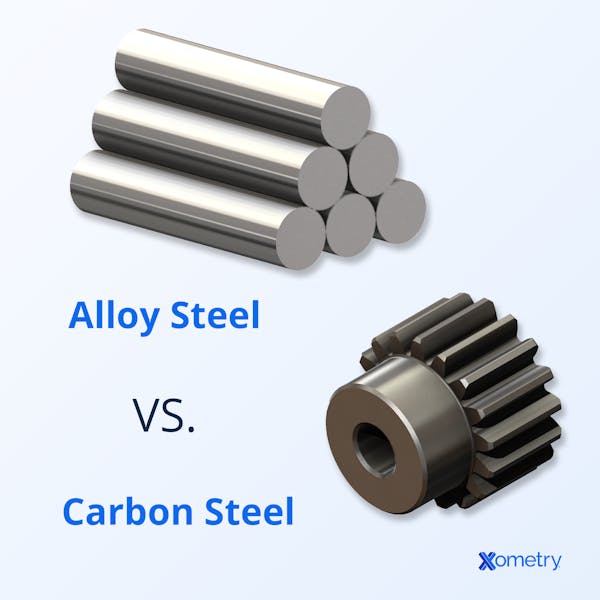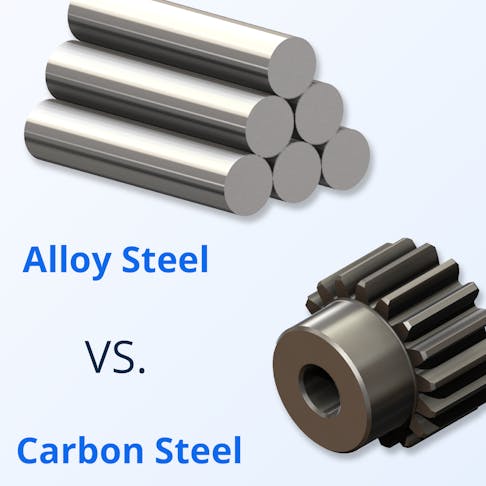There’s no denying that both alloy steel and carbon steel are extremely useful metals and are very popular among Xometry customers from a wide range of industries, but they’re so similar that it can be hard to know the difference so you can choose between them. They’re both strong, hard, and durable, and can be heat-treated to improve these factors. They’re both mainly made up of iron, with small amounts of other elements like carbon, chromium, molybdenum, manganese, and nickel. As if that’s not confusing enough, they can both be made in many different grades that each has its own set of unique benefits.
With all these similarities you could be inclined to believe that these metals are interchangeable, but you’d have to think again. There are some important differences that make them more or less suitable than the other in certain applications. We explain more about each of these steels further down and have even prepared a table that pits alloy steel and carbon steel against each other to see how they fare.
What is Alloy Steel?
Alloy steel has carbon along with other alloying elements in it, like aluminum, chromium, copper, manganese, nickel, silicon, or titanium. These other elements lend their strengths to the alloy steel, be it hardness, corrosion resistance, or durability. It’s suitable for high-temperature applications and is a common material in construction, automotive, aerospace, petrochemical, and power plants. Just a few of the parts it’s used for are gears, shafts, and axles.
Although there are many different steel alloy types, these generally fall into two categories: low-alloy steel and high-alloy steel. Low-alloy types are the most commonly used, popular in construction for pipes and beams. These are the alloys that will have carbon, manganese, silicon, copper, molybdenum, and/or nickel. They are ductile, but a bit weaker than other types.
High-alloy steel types have more than 5% of other elements (like chromium, vanadium, or tungsten) in them, which makes them extra strong and hard. They’re used for car and machinery parts, and in sectors like power generation, and chemical processing.
There’s also another one worth mentioning — tool steel. Used to make tools, this has a high carbon content and goodies like chromium, manganese, and tungsten to give it even more hardness and durability. Xometry offers auto-quoting for CNC machined parts in tool steel grades O1 and A2, among other alloy steels.

What is Carbon Steel?
Carbon steel is a metal made from iron with up to 2% carbon in it. It’s already strong and hard, but to make it even harder via heat treating processes. It’s used to make various machines and their parts, tools, bridges, car parts, and construction materials. One of the great things about it is that it can be used with various manufacturing methods, including the ones Xometry offers, like CNC machining, sheet cutting, sheet metal fabrication, and welding. Carbon steel types fall into four different categories depending on the amount of carbon in them:
- Low (aka “mild steel”): up to 0.30% carbon
- Medium: from 0.31% to 0.60%
- High: from 0.61% to 1.50%
- Ultra: up to 2%

| Property ↓ | Alloy Steel | Carbon Steel | Winner |
|---|---|---|---|
Property ↓ Thermal conductivity | Alloy Steel Good - 40-60 W/(mK) | Carbon Steel High - 45 W/(mK) | Winner Carbon |
Property ↓ Strength | Alloy Steel High | Carbon Steel Good | Winner Alloy |
Property ↓ Toughness | Alloy Steel High | Carbon Steel Good | Winner Alloy |
Property ↓ Tensile strength | Alloy Steel High - up to 960 MPa | Carbon Steel Good - Up to 450 MPa | Winner Alloy |
Property ↓ Ductility | Alloy Steel Good | Carbon Steel Fair | Winner Alloy |
Property ↓ Wear and tear resistance | Alloy Steel High | Carbon Steel Fair | Winner Alloy |
Property ↓ Corrosion resistance | Alloy Steel High (depending on alloying elements) | Carbon Steel Low (if not coated) | Winner Alloy |
Property ↓ Weldability | Alloy Steel Good | Carbon Steel High | Winner Carbon |
Property ↓ Machinability | Alloy Steel Fair to good (depending on alloying elements) | Carbon Steel Good to excellent (in low-carbon types) | Winner Carbon |
Property ↓ Magnetism | Alloy Steel Usually magnetic | Carbon Steel Magnetic (depending on carbon content) | Winner Depends on use |
Property ↓ Heat resistance | Alloy Steel High (depending on alloying elements) | Carbon Steel Fair (depending on carbon content) | Winner Alloy |
Property ↓ Melting point | Alloy Steel 1,400–1,500°C | Carbon Steel 1,425–1,530°C | Winner Both |
Property ↓ Heat treatable | Alloy Steel Yes | Carbon Steel Yes | Winner Both |
Property ↓ Cost | Alloy Steel High | Carbon Steel Fair | Winner Carbon |
Alloy Steel vs. Carbon Steel Properties
How Xometry Can Help
We hope this article was helpful in explaining the differences between alloy steel and carbon steel, and that you’ve managed to decide which one is best for your manufacturing needs. If neither sounds appealing, fret not! Stainless steel or nickel alloys can replace them both. Xometry offers many different services using these metals, including CNC machining, sheet cutting, sheet metal fabrication, and much more! You can easily get your free quote here, or for more information on any of these materials or our services, please feel free to reach out to one of our reps.
Disclaimer
The content appearing on this webpage is for informational purposes only. Xometry makes no representation or warranty of any kind, be it expressed or implied, as to the accuracy, completeness, or validity of the information. Any performance parameters, geometric tolerances, specific design features, quality and types of materials, or processes should not be inferred to represent what will be delivered by third-party suppliers or manufacturers through Xometry’s network. Buyers seeking quotes for parts are responsible for defining the specific requirements for those parts. Please refer to our terms and conditions for more information.


